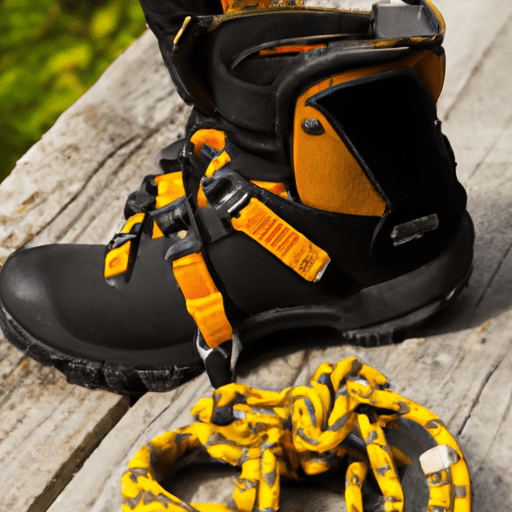Grab your leash and lace up your hiking boots – it's time to embark on an adventure with your furry best friend! In “Exploring the Great Outdoors: The Benefits of Hiking with Your Dog,” we uncover the numerous advantages of hitting the trails with your canine companion. From improved physical fitness to stronger bonds and mental well-being, hiking with your dog not only provides you with an opportunity to connect with nature but also enhances your overall quality of life. So, get ready to unleash the fun and explore the great outdoors with your four-legged hiking buddy!
Physical Benefits
Increased Exercise
Hiking with your dog provides an excellent opportunity to increase your physical activity levels. Unlike a leisurely walk in the park, hiking involves traversing different terrains, navigating obstacles, and climbing inclines, all of which require more effort and energy. By incorporating hiking into your routine, you and your furry companion can enjoy a rigorous workout that benefits your cardiovascular system, strengthens your muscles, and helps you maintain a healthy weight.
Weight Control
Regular hiking can be a great way to help both you and your dog maintain a healthy weight. The combination of the elevated heart rate, increased calorie burn, and the varying terrain can contribute to effective weight management. Additionally, hiking is a low-impact activity that puts less stress on your joints compared to activities like running or jogging, making it suitable for dogs of various ages and breeds.
Improved Cardiovascular Health
Hiking is an excellent cardiovascular exercise for both humans and dogs. The continuous movement, elevation changes, and varied terrain challenge your heart and lungs, promoting a healthy cardiovascular system. Consistent hiking can lead to improved endurance, lower blood pressure, and reduced risk of heart disease for both you and your furry friend.
Strengthened Muscles
Hiking involves traversing different surfaces, which engages and strengthens a variety of muscles. Uphill climbs engage your quadriceps, glutes, and calves, while downhill descents activate your hamstrings. Walking on uneven terrain also works your core muscles and stabilizers, helping to improve balance and proprioception. For your dog, hiking can provide similar benefits, particularly in their leg, back, and core muscle groups.
Mental Benefits
Reduced Stress and Anxiety
Spending time in nature and engaging in physical activity has been proven to reduce stress and anxiety levels. Hiking with your dog allows you to escape the hustle and bustle of daily life and immerse yourself in the calming beauty of the great outdoors. The sights, sounds, and smells of nature can help both you and your furry companion relax, unwind, and alleviate stress.
Improved Mood
Hiking releases endorphins, also known as the “feel-good” hormones, which can boost your mood and leave you feeling happier and more content. The combination of physical activity, fresh air, and the serenity of nature can have a positive impact on your overall well-being. Additionally, spending quality time with your dog strengthens the bond between you, enhancing feelings of companionship and happiness.
Enhanced Mental Stimulation
Hiking is not just a physical activity; it also provides mental stimulation for both you and your dog. Exploring new trails, navigating obstacles, and encountering unfamiliar sights and smells engages your senses and keeps your mind active. For dogs, exploring new environments provides mental enrichment, which can help combat boredom and prevent behavioral problems.
Bonding and Socialization
Hiking with your dog offers a unique opportunity to bond and strengthen your relationship. The shared experiences, challenges, and adventures create lasting memories and deepen the connection between you and your furry friend. Additionally, encounters with other hikers and their dogs can provide opportunities for socialization, helping your dog develop good manners and improving their overall behavior.
Exploration and Discovery
Discovering New Trails and Landscapes
One of the major advantages of hiking with your dog is the opportunity to explore new trails and landscapes. Whether it's a scenic mountain path, a tranquil woodland trail, or a coastal route with breathtaking views, each adventure brings something new and exciting. By venturing off the beaten path, you and your dog can discover hidden gems and experience the wonders of nature together.
Connecting with Nature
Spending time in nature has numerous benefits for both humans and dogs. The sights, sounds, and scents of the natural environment have a calming effect on the mind, reduce stress, and improve overall well-being. Additionally, being surrounded by nature offers a chance to disconnect from technology and immerse yourself in the present moment. Your dog will also appreciate the opportunity to explore, sniff, and connect with their natural instincts.
Wildlife Encounters
While hiking, you and your dog may have the exciting opportunity to encounter wildlife. From deer grazing in meadows to squirrels scurrying up trees, these sightings can be both thrilling and educational. However, it is important to remember that wildlife should be observed from a safe distance to ensure the animals' well-being and your own safety. Keep your dog on a leash and respect the natural habitats you encounter.
Training Opportunities
Obedience Training
Hiking provides an ideal environment to reinforce and practice obedience training with your dog. From basic commands like “sit” and “stay” to more advanced skills such as “leave it” or “heel,” the trail offers the perfect setting for real-life training scenarios. By consistently practicing commands during your hikes, you can improve your dog's obedience and responsiveness, ensuring a safe and enjoyable hiking experience for both of you.
Socialization Skills
Hiking allows your dog to encounter and interact with other hikers, dogs, and even wildlife. This exposure to different stimuli helps develop your dog's socialization skills, teaching them how to behave appropriately in various situations. Meeting new dogs and people on the trail can make your dog more comfortable and confident in social settings, preventing aggressive behaviors and ensuring harmony during your outdoor adventures.
Improved Recall Command
Recall, or the ability to come back to you when called, is an essential command for any dog, especially when hiking off-leash. Regular hikes provide valuable opportunities to practice and reinforce this command. Start by practicing in controlled environments, gradually increasing the level of distractions as your dog becomes more reliable. Reinforcing a strong recall command ensures that your dog stays safe and can explore more freely during your hikes.
Safety Precautions
Check for Leash Regulations
Before hitting the trail, it's essential to research and check for any leash regulations or requirements in the area you plan to hike. Some trails may require dogs to be on a leash at all times, while others allow dogs off-leash as long as they are under control. Respecting these regulations is not only considerate towards other hikers but also helps protect the local wildlife and preserve the natural environment.
Carry Essential Gear
When hiking with your dog, it's important to carry essential gear to ensure their comfort and safety. Items such as a sturdy leash, a collapsible water bowl, poop bags, and a basic first aid kit are essential. Depending on the duration and difficulty of your hike, you may also need to pack additional items, such as extra water, a portable dog bed or mat, and high-energy snacks for your pup.
Stay Hydrated
Just like humans, dogs need to stay hydrated during physical activities, especially when hiking. Bring an adequate supply of fresh water for both you and your dog, especially if you're hiking in warm or hot weather conditions. Make sure to offer your dog water regularly to prevent dehydration and overheating, and pay attention to their behavior and body language for any signs of fatigue or thirst.
Prevent Tick and Flea Infestations
While hiking, your dog can come into contact with ticks and fleas, which can lead to health issues. Protect your furry companion by using tick and flea preventive products recommended by your veterinarian. It's also essential to regularly check your dog for any signs of ticks or fleas, paying close attention to areas like the ears, armpits, and between the toes. Promptly remove any ticks you find to prevent potential diseases.
Keep a Watchful Eye
When hiking with your dog, it's crucial to be aware of their behavior, especially in unfamiliar environments. Keep an eye out for potential hazards that could harm your dog, such as poisonous plants, cliffs, or bodies of water that may pose a drowning risk. Additionally, pay attention to signs of fatigue, overheating, or discomfort in your dog, and be prepared to adjust your hike or take breaks as needed.
Choosing the Right Trail
Consider Dog-Friendly Trails
When planning a hike with your dog, it's important to choose trails that are dog-friendly and welcome furry companions. Research local parks, nature reserves, and hiking trails that explicitly allow dogs. Look for information on leash policies, waste disposal stations, and any specific rules or restrictions you need to follow. Opting for dog-friendly trails ensures a positive and stress-free experience for both you and your four-legged friend.
Check for Trail Restrictions
While some trails are dog-friendly, others may have restrictions or specific rules in place. These restrictions can include leash requirements, restricted access during certain seasons, or areas where dogs are not permitted at all. Always check for any trail restrictions before heading out, ensuring that you choose a trail that aligns with both your dog's and your hiking preferences.
Assess Trail Difficulty
Consider the difficulty level of the trail when planning your hike with your dog. Some trails may have steep inclines, rocky terrain, or long distances that may be challenging for dogs, particularly those who are young, senior, or have physical limitations. Assess the fitness level of your dog, take their age and health into account, and choose a trail that suits their abilities to prevent any unnecessary strain or injuries.
Plan for Weather Conditions
Before heading out on a hiking adventure, check the weather forecast for your desired trail. Extreme heat, cold temperatures, heavy rain, or storms can pose risks to you and your dog's safety. Avoid hiking during extreme weather conditions and choose a day with favorable weather to ensure an enjoyable experience. If you plan to hike during hot weather, opt for trails with shaded areas and carry extra water for your dog to prevent heat-related issues.
Preparing Your Dog for Hiking
Visit the Veterinarian
Before embarking on any hiking adventures with your dog, schedule a visit to the veterinarian for a thorough check-up. Ensure that your dog is up to date on vaccinations and parasite prevention. Your veterinarian can assess your dog's overall health, fitness level, and provide any specific recommendations or precautions based on your dog's breed, age, and medical history.
Build Up Endurance Gradually
If your dog is not accustomed to regular exercise or hiking, it's important to build up their endurance gradually. Start with shorter, easier hikes and gradually increase the distance and difficulty level over time. This allows your dog's muscles and joints to adapt and helps prevent fatigue or injuries. Listen to your dog's cues and adjust the pace and intensity of your hikes accordingly.
Train Basic Commands
Before hitting the trail, ensure that your dog has a solid foundation in basic obedience commands. Commands such as “sit,” “stay,” “come,” and “leave it” are essential for maintaining control and ensuring your dog's safety during your hikes. Practice these commands in different environments, gradually increasing the level of distractions, to build your dog's reliability and responsiveness.
Pack Dog Essentials
When preparing for a hike, it's important to pack essential items specifically for your dog. Bring enough food and treats to sustain your dog's energy levels throughout the hike. Consider packing a comfortable dog bed or mat for breaks and resting periods. Don't forget to bring waste disposal bags to clean up after your dog and pack any prescribed medications they may need. Tailor your packing list based on your dog's individual needs and the duration of your hike.
Dog-Friendly Hiking Gear
Proper Harness or Collar
Investing in a proper harness or collar is essential for hiking with your dog. A well-fitting harness or collar allows you to have better control over your dog's movements while preventing strain on their neck and throat. Ensure that the harness or collar is comfortable, secure, and doesn't restrict your dog's movement. Additionally, attach identification tags to the harness or collar in case your dog gets separated from you during the hike.
Leash Options
Choosing the right leash for your dog can significantly impact your hiking experience. Opt for a sturdy leash that is appropriate for your dog's size and strength. A retractable leash can provide your dog with more freedom to explore while still allowing you to maintain control when needed. However, in areas with leash regulations, a standard 6-foot leash is often required. Consider carrying an extra waist belt or hands-free leash for added convenience during your hikes.
Appropriate Footwear
Your dog's paw pads are sensitive and can be prone to injuries when hiking on rough or hot surfaces. Protect their paws by investing in appropriate footwear, such as dog boots or protective paw balms. These can provide traction, insulation, and protect their paws from sharp rocks, thorns, or hot pavement. Before your hike, gradually introduce your dog to wearing the boots at home to ensure they are comfortable and properly fitted.
Backpack for Dogs
If your dog is physically fit and capable of carrying their own gear, consider investing in a backpack designed specifically for dogs. Dog backpacks are a great way to distribute weight evenly and allow your dog to contribute to carrying their essentials, such as water, food, or waste disposal bags. Ensure that the backpack fits properly and does not cause any discomfort or strain on your dog's back or shoulders.
Portable Water Bowl
Proper hydration is crucial for your dog's well-being during hikes. Pack a lightweight, portable water bowl that is easy to carry and allows your dog to drink comfortably. Look for bowls that are collapsible or designed specifically for outdoor activities. Offering regular water breaks to your dog is essential, even if they have their own backpack with a water supply.
Common Challenges and Solutions
Dealing with Trail Etiquette
When hiking with your dog, it's important to be mindful of trail etiquette and respect other hikers. Keep your dog under control, be aware of other hikers' comfort levels around dogs, and yield the right of way when necessary. Always clean up after your dog and dispose of waste properly. Additionally, if your dog tends to bark or lunge at other hikers or animals, consider using a muzzle or a gentle leader to prevent any potential conflicts.
Managing Common Behavior Issues
Hiking can present unique challenges for dogs, especially those prone to behavior issues. If your dog becomes overwhelmed, anxious, or reactive in certain situations, it's essential to manage their behavior effectively. Training, desensitization, and counter-conditioning techniques can be helpful in addressing these issues. Seek guidance from a professional dog trainer or behaviorist to develop an appropriate training plan for your dog's specific needs.
Addressing Fear or Anxiety
Hiking in unfamiliar environments may trigger fear or anxiety in some dogs. Whether it's a fear of heights, loud noises, or encountering other dogs, it's important to understand and address your dog's fears. Gradual exposure, positive reinforcement, and patience can help desensitize your dog and build their confidence over time. If your dog's fear or anxiety persists, consult with a professional for additional guidance and support.
Post-Hike Care
Check for Injuries
After every hike, it's crucial to check your dog for any injuries, scratches, or wounds. Inspect their paws for cuts, cactus spines, or signs of irritation. Check their body for ticks, fleas, or any unusual swelling or tenderness. Pay attention to any changes in your dog's behavior indicating discomfort or pain. If you notice any injuries or concerns, consult your veterinarian for appropriate treatment and care.
Proper Hydration and Nourishment
Replenishing your dog's fluids and providing a nutritious meal after a hike is important for their recovery. Offer them fresh water and a balanced meal to help restore their energy levels. Depending on the duration and intensity of the hike, your dog may require additional food or special treats to aid in their post-exercise recovery. Consult your veterinarian for specific dietary recommendations based on your dog's individual needs.
Cleanliness and Grooming
After a muddy or dusty hike, it's essential to clean your dog's paws, coat, and ears to prevent any potential infections or irritations. Use a damp cloth or pet-safe wipes to clean their paws thoroughly, removing any dirt or debris. Brush their coat to remove any twigs, leaves, or tangles and check their ears for any signs of irritation or moisture. Proper grooming after a hike helps keep your dog comfortable and reduces the risk of skin issues.






